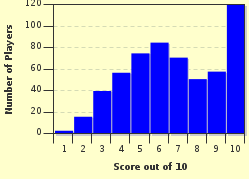Quiz Answer Key and Fun Facts
1. One of the simplest forms is also one of the most common. Not only is binary form a precursor to several other forms, but it is often embedded within these other forms. How many main sections does a binary form contain?
2. Pieces in binary form can often be categorized according to their harmonic motion and melodic content. Which of the following terms would describe a binary form in which the first section saw a clear cadence in the tonic key and melodic material from the first section returned in the second?
3. Ternary form, as the name implies, has three distinct parts. In most cases, the third section is a literal or amended repetition of the first part. Which of these types of pieces constitutes a ternary form?
4. In ternary (as well as other forms), a special section is sometimes included to bring the music back to the original material. In the case of ternary, it prepares the return of the A material. True or false: this section is called a retransition.
5. Sonata form is one of the most recognized and most utilized forms in western art music. Of the following sections, which is not commonly held to be a key component of a movement in sonata form?
6. In a four-movement sonata or symphony, which movement would most likely be written in sonata form?
7. The theme and variations form is one of the easiest to understand. A composer will present a theme followed by several variations. Brahms composed a famous set of 25 variations (and a fugue to boot) for piano based upon a theme by what Baroque composer?
8. A five part rondo would most commonly be realized in which of the following ways?
9. The seven-part rondo is often molded into what is called sonata rondo. Which of the following conditions generally hold(s) true for sonata rondos?
10. Art songs generally belong to one of two categories. Strophic songs set multiple lines of text to the same music. Is 'through-composed' the term that characterizes songs that are continuous and not repetitive?
Source: Author
bmrsnr
This quiz was reviewed by FunTrivia editor
CellarDoor before going online.
Any errors found in FunTrivia content are routinely corrected through our feedback system.

